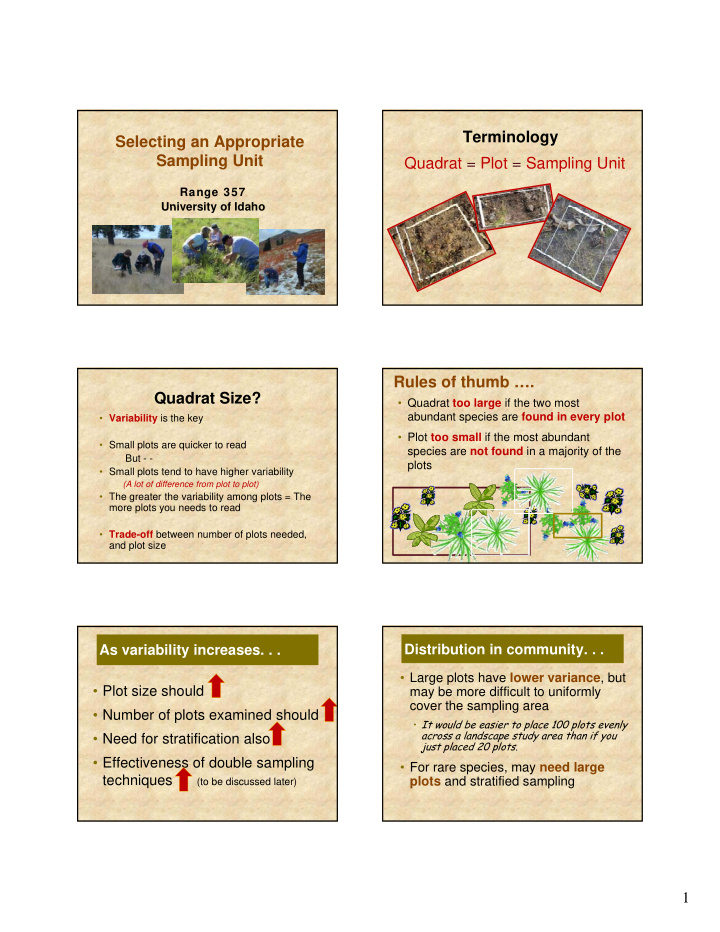



Terminology Selecting an Appropriate Sampling Unit Quadrat = Plot = Sampling Unit Range 357 University of Idaho University of Idaho Rules of thumb …. Quadrat Size? • Quadrat too large if the two most abundant species are found in every plot • Variability is the key • Plot too small if the most abundant • Small plots are quicker to read species are not found in a majority of the But - - plots plots • Small plots tend to have higher variability (A lot of difference from plot to plot) • The greater the variability among plots = The more plots you needs to read • Trade-off between number of plots needed, and plot size Distribution in community. . . As variability increases. . . • Large plots have lower variance , but • Plot size should may be more difficult to uniformly cover the sampling area • Number of plots examined should • It would be easier to place 100 plots evenly • It would be easier to place 100 plots evenly across a landscape study area than if you • Need for stratification also just placed 20 plots. • Effectiveness of double sampling • For rare species, may need large techniques (to be discussed later) plots and stratified sampling 1
Plant size. . . Bottom line • Larger the average-sized plant the • Sparse vegetation requires larger larger the sampling frame needed plots or transects than dense vegetation • Rules of Thumb: • Plot should be larger than average-sized plant Plot should be larger than average sized plant, and larger than average space between plants. • Uniform vegetation requires fewer and • Plot is too small if >10% of plot do not contain smaller plots than diverse/variable the plants of interest vegetation May require a “stratified” scheme Sampling different life forms Several plot sizes • Difficult to sample different life forms in one protocol (moss, grass, forbs, shrubs, trees, etc. One size does not fit all One s ze does not f t all http://edcintl.cr.usgs.gov/senegal2/gifs/savanna.gif Perimeter to Area Concerns • Perimeter to area ratio decreases as plot size increases • If borderline decisions (deciding if plant in or If borderline decisions (d idi if l t i out) are difficult to make, then select a plot size that reduces perimeter:area ratio Or, select size of plot based on species of greatest interest 2
Circle Shape of Sample Unit • Less perimeter per area than square or rectangle • Number and size of sample units are the first and most important • Perimeter decisions are difficult to make considerations when clipping vegetation, so circles are often used often used • However, shape of quadrat or frame is • However shape of quadrat or frame is also important and can reduce variation • Reduced perimeter: area ratio is also in the sample good in communities with large clonal plants Square Rectangles • Greater perimeter:area ratio than • More likely to cut across plants rather than circles, but less than rectangles. be completely occupied by plants • Most frequently used to estimate • Rarely completely occupied by bare spaces frequency because presence/absence • Often has lower variance than square or Often has lower variance than square or is easy to estimate. is easy to estimate circles • Squares are easier to estimate % cover, • Can reduce variability in sparsely vegetated than circles but not as easy as communities rectangles. • Easier to estimate % cover than circles or squares Take Home Message • Plot Size and Number of Plots are Most Important • Plot Shape is “fine tuning“ http://www.habitats.freeserve.co.uk/images/quadrats.jpg 3
Recommend
More recommend